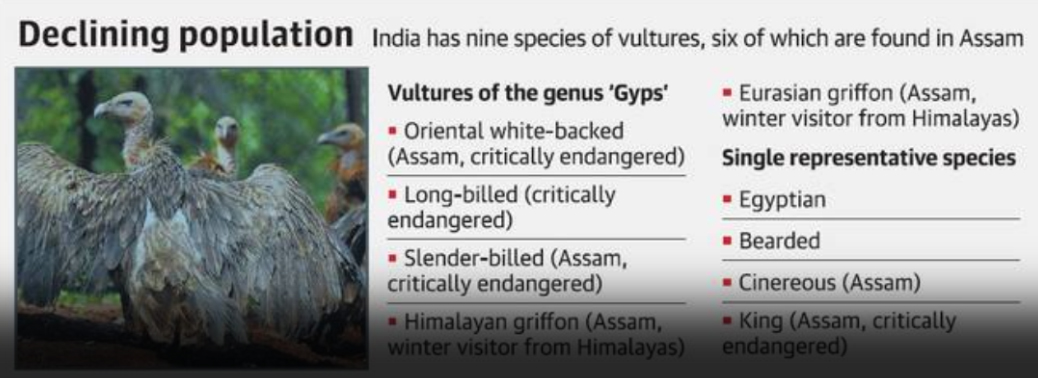POISONED CATTLE CARCASS KILLS 37 VULTURES
31, Mar 2019

Prelims level : E & BD – Animal Species
Mains level : GS III - Conservation, environmental pollution and degradation, environmental impact assessment
- 37 vultures belonging to three endangered species died in eastern Assam after feeding on pesticide-laced cattle carcass.
- Most of the 37 vultures that died are Himalayan griffon. A few are oriental white-backed and slender-billed vultures.
- A study by the Bombay Natural History Society and other organisations in the 1990s found that the population of the Gyps group — Himalayan griffon, white-backed and slender- billed are among its members — in India and Nepal declined from about 40 million by 99.9% in just two decades.
Indian Vulture Crisis:
- India is most favourable region for Vultures: Hindus do not eat cows, which they consider sacred, and when a cow dies, it is left to be fed on by vultures. India has a high species diversity and hence vultures get lot of food. Nine species of vulture can be found living in India. But today, most are in danger of extinction due to a veterinary drug called diclofenac (vultures do not have a particular enzyme to break down diclofenac).
Diclofenac
- Diclofenac is a common anti-inflammatory drug administered to livestock and is used to treat the symptoms of inflammation, fevers and/or pain associated with disease or wounds. Diclofenac leads to renal failure in vultures damaging their excretory system [direct inhibition of uric acid secretion in vultures].
- Gyps species were the most affected by diclofenac.
- The population of the White-rumped vulture (Gyps bengalensis) fell 99.7% between 1993 and 2002.
- The populations of the Indian vulture (Gyps indicus) and the slender-billed vulture (Gyps tenuirostris) fell 97.4%.
- The percentages differ slightly because the white-rumped vulture is more sensitive to diclofenac than the other two species, but all three were in danger of extinction.
- Two other species of Gyps, the Himalayan vulture (Gyps himalayensis) and the Eurasian griffon (Gyps fulvus) were less affected because they come to India only in winters
- They are exclusively mountain-dwelling and hence less vulnerable to diclofenac contamination.
- Vulture populations have continued to decline in India at a rate of between 20% and 40% each year since 2007.
Consequences of Depopulation of Vultures:
- Vultures previously played an important role in public sanitation in India and their disappearance has resulted in an explosion of rats and wild dogs and the spread of diseases resulting in an estimated cost of up to ₹1700 billion (US$25 billion) (as of 2015).
- The carcasses formerly eaten by vulture’s rot in village fields leading to contaminated drinking water.
- These newly abundant scavengers are not as efficient as vultures. A vulture’s metabolism is a true “dead-end” for pathogens, but dogs and rats become carriers of the pathogens.
- The mammals also carry diseases from rotting carcasses such as rabies, anthrax, plague etc. and are indirectly responsible for thousands of human deaths.
Conservation Status of India Vultures [As of December-2018]
Critically Endangered
- White-Rumped Vulture (Gyps bengalensis)
- White-Backed Vulture (Gyps africanus)
- Ruppell’s Vulture (Gyps rueppellii)
- Indian Vulture (Gyps indicus)
- Slender-Billed Vulture (Gyps tenuirostris)
Endangered
- Cape Vulture (Gyps coprotheres)
Near Threatened
- Himalayan Vulture (Gyps himalayensis)
Least Concern
- Griffon Vulture (Gyps fulvus)
Critically Endangered
- White-Rumped Vulture (Gyps bengalensis)






